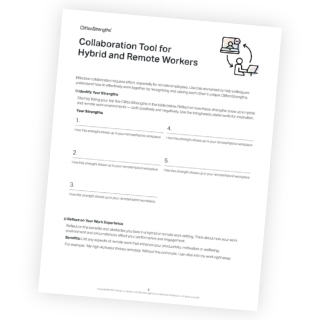Collaboration at Work: Building Powerful Partnerships With Strengths
- What Is the Difference Between Teamwork and Collaboration?
- The Role of Strengths in Collaboration
- How to Develop Collaboration in Teams
- What Is Cross-Functional Collaboration?
- What Makes a Powerful Partnership?
- Common Challenges in Partnerships
- Remote Collaboration: Tools and Best Practices
- Recognizing and Rewarding Great Collaboration
Introduction
Collaboration has always been an essential component of work. But in the modern workplace, intentional, effective collaboration has become even more important. Teams are no longer just groups of individuals completing assigned tasks -- they are dynamic systems where effective collaboration can mean the difference between innovation and stagnation.
Great collaboration does more than drive innovation and growth. It's also extremely rewarding for employees.
Yet, the nuances that make collaboration and partnerships truly powerful are often overlooked. Understanding the balance between teamwork and collaboration, making the most of individual strengths and building a culture based on trust are essential to unlocking the full potential of any partnership.
Whether you're leading a team, navigating a partnership or striving to improve your company's collaborative culture, our insights can help you succeed.
Gallup data show that employees with at least one collaborative relationship are:
29% more likely to say they will stay with their company for the next year.
43% more likely to intend to remain with their current employer for their entire career.

01. What Is the Difference Between Teamwork and Collaboration?
Understanding the difference between teamwork and collaboration allows organizations to apply each approach where it is most effective. While they share similarities, their goals and processes differ significantly.
Both approaches involve working toward a common goal. However, teamwork emphasizes efficiency, while collaboration focuses on the interactive process of sharing ideas, resources and responsibilities.
Teamwork: Roles, Structure and Efficiency
Teamwork involves assigning roles and working together toward a specific, often structured, objective. Each team member contributes their individual expertise, and the combined efforts determine the outcome.
Example
In a hospital setting, a surgical team operates with precision. The surgeon performs the procedure, the anesthesiologist monitors the patient and the nurses provide vital support. Each role is essential and clearly defined.
Teamwork thrives on:
- Defined RolesEach person knows their responsibilities.
- Clear HierarchyDecisions flow through a chain of command.
- Task CompletionFocused on completing tasks within a framework.

Collaboration: Innovation, Combined Effort and Shared Input
Collaboration emphasizes co-creation, where individuals combine their knowledge and skills to achieve shared goals. Unlike teamwork, collaboration is less rigid and thrives in environments requiring innovation and problem-solving.
Example
A product design team brainstorming a new app combines creative thinking, data analysis and user feedback to develop a unique solution.
Collaboration relies on:
- Shared OwnershipContributions blend seamlessly.
- Fluid RolesPartners adapt based on the task at hand.
- Creative Problem-SolvingEncourages divergent thinking to generate solutions.
By emphasizing the key differences between teamwork and collaboration and clarifying where each approach applies, organizations can help employees understand how to contribute to partnerships effectively and what to expect from their coworkers.
02. The Role of Strengths in Collaboration
A vital component of successful collaboration is understanding and using individual strengths. When people operate in their areas of greatest talent, they are more engaged, confident and productive.
Strengths gives teams a common language to communicate more effectively and understand each other faster. When you know your strengths, you can clearly articulate what you excel at -- and where you may need support -- making collaboration more efficient.
This approach is especially valuable for hybrid and remote teams with limited face-to-face interactions. Focusing on strengths in a constantly evolving work environment helps individuals adapt quickly and collaborate smoothly, regardless of location.
Each person's strengths contribute uniquely to a collaborative effort. For example:
Executors turn plans into actionable results.
Influencers inspire action and communicate effectively.
Relationship Builders connect and unify diverse team members.
Strategic Thinkers provide foresight and innovative solutions.
When strengths are complementary, they enhance effectiveness. Partners who excel in different areas fill gaps in each other's skill sets. Examples include:
- A data-driven marketer collaborating with a visionary creative director to balance analytics with storytelling.
- An analytical project manager working alongside a charismatic leader to ensure both planning and motivation are top priorities.

Successful organizations intentionally align roles with strengths. This involves:
- Conducting strengths workshops to understand team dynamics.
- Pairing individuals with complementary talents.
- Revisiting roles as projects evolve to ensure alignment.
Example
An engineering firm paired a technical lead who excelled in execution with a client-facing consultant skilled at relationship building. Together, they enhanced project delivery while maintaining strong customer engagement.
03. How to Develop Collaboration in Teams
Creating a collaborative culture requires deliberate actions at every organizational level. It involves fostering trust, promoting shared accountability and aligning processes with collaborative goals.
Psychological safety is the foundation of collaboration. It allows individuals to share ideas and take risks without fear of judgment. Organizations can promote psychological safety by:
- Encouraging Open Dialogue: Leaders should actively seek input from all team members, especially quieter voices.
- Addressing Toxic Behaviors: Leaders should immediately address negative dynamics such as interrupting or dismissive comments.
- Modeling Vulnerability: Leaders can share their own challenges to show that mistakes are learning opportunities.
Clarity is critical for collaboration. Teams perform best when they understand what success looks like and how their roles contribute to the overall mission.
- Set SMART Goals: Objectives should be Specific, Measurable, Achievable, Relevant and Time-bound.
- Communicate the Why: Connecting individual tasks to the larger purpose boosts motivation.
Celebrating collaboration reinforces its importance.
- Public Recognition: Highlight successes during team meetings or newsletters.
- Peer Nominations: Allow colleagues to recognize each other's contributions.
Bring and Need Strengths Statements
Every strength contributes something unique to a partnership. Each person can help their partner use their strengths more effectively.
Use these simple statements to describe what you bring to a partnership and what you need from a partner.

I Bring: intensity and stamina of effort

I Bring: attention to messages that must be heard

I Bring: social depth and transparency

I Bring: a learning perspective and excitement for the learning process
Case Studies
Explore how these organizations are building thriving workplaces with strengths.
04. What Is Cross-Functional Collaboration?
Cross-functional collaboration occurs when different teams or departments within an organization work together.
This approach brings together people with varied skills, expertise, and perspectives, often from different functional areas such as marketing, sales, finance, IT, operations, and product development.
Cross-functional collaboration aims to combine each team's diverse strengths and knowledge to solve complex problems, innovate and improve overall performance. This type of collaboration promotes better communication and a more holistic approach to decision-making by removing barriers between departments.
Benefits of Cross-Functional Collaboration
- Enhanced Innovation: Bringing together team members with diverse perspectives encourages creativity and leads to innovative solutions.
- Improved Communication: Cross-functional teams improve communication and understanding across the organization, ensuring that all departments are aligned and working toward common goals.
- Increased Employee Engagement: Collaborative environments that encourage knowledge sharing lead to higher employee engagement. A highly engaged workforce can increase profitability by 23%.
- Holistic Decision-Making: Involving different people and functions in decision-making ensures that various viewpoints are considered, leading to more comprehensive and effective outcomes.
Strategies for Effective Cross-Functional Collaboration
By implementing these strategies, organizations can fully realize the benefits of cross-functional collaboration, fostering innovation and enhancing performance.

Establish Clear Goals and Roles
Define objectives and roles to ensure all team members understand their responsibilities and contributions toward the common goal.

Encourage Open Communication
Promote transparency and regular information sharing to build trust and prevent misunderstandings.

Use Technology
Use collaborative tools and platforms for seamless communication and project management across different functions.

Provide Training and Support
Offer resources and training to help team members develop effective cross-functional collaboration skills.

Promote a Collaborative Culture
Recognize and reward collaborative efforts to help reinforce the importance of a culture that values diverse perspectives and teamwork.
05. What Makes a Powerful Partnership?
Effective collaboration between two people can lead to outstanding results. But to achieve those results, both people must know the eight key elements of a powerful partnership.
Eight Key Elements Define Powerful Partnerships
These principles apply to professional relationships, project collaborations, and even personal alliances.
Explore each of these elements to see the effect they have on collaboration, key statements that are the best predictors of success and examples of effective collaboration in practice.

1. Complementary Strengths
Nobody is great at everything, but partnerships let people combine their unique strengths to achieve more together.
Partners with complementary strengths can fill in gaps in each other's abilities. This specialization allows each person to focus on what they do best, creating what neither could achieve alone.
Imagine a welding torch that operates using oxygen and acetylene gases. Alone, each gas has limited capability, but when combined, they produce an intensely powerful flame. In partnerships, this is when one partner excels at generating ideas while the other is skilled at implementing them. The combined effort becomes more effective than working alone.
Steve Jobs and Steve Wozniak's partnership at Apple highlights the power of complementary strengths. Jobs excelled at visionary thinking and marketing, while Wozniak was a technical genius in engineering. Alone, neither could have built Apple into the tech giant it became, but together, they combined their unique talents to revolutionize the industry. Jobs shaped the vision and market strategy, while Wozniak focused on innovation, demonstrating how partnerships can achieve what individuals cannot.
Best Predictors of Collaborative Success:
- We complement each other's strengths.
- We need each other to get the job done.
- They do some things much better than I do, and I do some things much better than they do.
Practical Scenario:
A creative marketing strategist works with a data-driven analyst to design campaigns. The strategist focuses on bold, engaging ideas, while the analyst ensures these ideas align with market trends and deliver measurable results.
2. A Common Mission
A shared purpose holds a partnership together. Without it, even the most talented collaborators can waver.
A strong partnership requires both parties to work toward a shared goal, even when personal motivations differ. A common mission provides focus and resilience during challenges.
When Edmund Hillary and Tenzing Norgay set out to climb Mount Everest, their backgrounds, motivations and personal ambitions differed greatly. Hillary, a New Zealander, was driven by exploration, while Norgay, a Sherpa from Nepal, saw the climb as a way to honor his heritage and advance his community. Despite their differences, a singular purpose united them: to reach the summit. This shared goal helped them navigate extreme conditions and dangerous terrain, overcoming obstacles that would have defeated less unified partners.
Best Predictors of a Common Mission:
- We share a common goal.
- We have a common purpose for what we do.
- We believe in the same mission in life.
Practical Scenario:
Two startup founders may have different goals -- one wants financial independence, and the other wants to make an impact on society -- but their shared purpose of creating a sustainable business keeps them aligned.
3. Fairness
The most trusting and satisfying partnerships happen when workloads are equal and efforts are valued and rewarded fairly.
Fairness does not always mean sharing work equally -- it means sharing efforts and benefits equally. Partnerships thrive when both people feel their contributions are valued and recognized. A lack of fairness can lead to resentment, diminishing the partnership's effectiveness.
Bill Hewlett and Dave Packard, co-founders of Hewlett-Packard, exemplified fairness in their leadership approach. They matched their salaries and shared responsibilities equally, even during difficult times. This built trust between them and modeled fairness across their organization, earning the loyalty of their employees.
Best Predictors of Excellent Alliances:
- We share the workload fairly between us.
- We do not have to keep track of who does what and who gets credit for what.
- We see each other as equals -- one is not better than the other.
Practical Scenario:
In an architecture firm, a senior architect may handle client presentations while a junior partner manages detailed drafting. Although the roles differ in visibility, both partners agree that their contributions are essential and ensure recognition reflects their input.
4. Trust
Trust is the foundation of any partnership. Without it, collaboration turns into micromanagement.
Trust allows partners to focus on their responsibilities without doubting the other's commitment. This reduces friction, enhances efficiency and provides the confidence to confront challenges.
Studies on teamwork reveal that trust reduces cognitive load by allowing individuals to anticipate their partner's actions. In partnerships with strong trust, people make decisions faster, and execution becomes seamless. Partners who consistently keep their promises build up trust that sustains collaboration over time.
In a good collaboration, 58% of partners strongly agree that they trust each other, and another 29% score the statement a 4 on a 5-point scale. In a poor partnership, less than 3% strongly agree they trust each other, while 50% strongly disagree.
Ruth Bader Ginsburg and Sandra Day O'Connor, the first two women on the U.S. Supreme Court, built a partnership founded on trust and mutual respect. Despite differing ideologies, they worked together to advance gender equality and support each other in a male-dominated field. Their trust minimized friction, fostered collaboration and amplified their shared impact on societal change.
Best Predictors of Trust:
- We can trust each other.
- We can count on each other to do what the other says they will do.
- They tell others how good I am, and I tell others how good they are.
Practical Scenario:
A senior lawyer trusts a junior associate to conduct thorough research for a case, while the associate relies on the lawyer to argue the case effectively in court. This mutual trust streamlines their workflow and ensures success.
5. Acceptance
Partnerships flourish when individuals embrace each other's differences.
Rather than trying to change or "fix" their partner, successful collaborators focus on strengths and accept weaknesses. Acceptance builds mutual respect and reduces unnecessary conflict.
LeBron James and Anthony Davis of the Los Angeles Lakers exemplify acceptance in their partnership. James, known for his all-around brilliance and vocal leadership, complements Davis, who is quieter but dominates with his defensive and offensive versatility. While James often takes the spotlight as the face of the franchise, he fully embraces Davis as the team's centerpiece on the court. In return, Davis respects James' leadership and allows him to set the team's tone. Their acceptance of each other's roles and contrasting styles were instrumental to the Lakers' 2020 NBA championship win.
Best Predictors of Acceptance:
- We focus on each other's strengths, not weaknesses.
- We accept each other as we are and don't try to change each other.
- We are understanding of each other when one of us makes mistakes.
Practical Scenario:
Two tech startup founders -- one who thrives under pressure, and the other who prefers careful planning -- recognize these differences as advantages, balancing each other's tendencies and working harmoniously.
6. Forgiveness
Mistakes and missteps happen, but the ability to forgive ensures partnerships survive and grow stronger.
Holding onto resentment or seeking revenge undermines collaboration. Forgiveness means acknowledging mistakes, letting go of grievances and refocusing on shared goals.
Although minor disagreements happen in good and bad partnerships, serious violations of trust are rare among the best pairs. Only 18% of good partnerships suffer a real dispute. Among bad partnerships, the number jumps to 40%.
If a falling-out does happen, those in a good partnership are better at working through it. When something serious enough to require forgiveness transpires, 85% of those in good partnerships do forgive. Those in bad partnerships patch things up only 14% of the time.
Oprah Winfrey and Iyanla Vanzant experienced a falling-out in the 1990s due to misunderstandings about Vanzant pursuing her own show. Years later, they reconciled publicly, acknowledging their mistakes and rebuilding trust. Their forgiveness not only healed their relationship but also allowed them to collaborate again, inspiring others with their renewed partnership.
Best Predictors of Good and Bad Partnerships:
- There have been times when either my collaborator or I have violated the other's trust.
- When either of us has violated the other's trust, we have been able to forgive each other.
Practical Scenario:
After a project delay causes tension, two managers discuss the issue, forgive each other for any missteps and set clearer communication expectations moving forward.
7. Communicating
Clear and consistent communication prevents misunderstandings and keeps partnerships aligned.
Effective communication ensures both partners stay informed and supportive of each other's efforts, which includes active listening, sharing updates and discussing needs openly.
Partnerships that thrive tend to agree with statements like "We rarely misunderstand each other" and "We are good listeners for each other." Communication is about speaking and understanding, confirming and acting on shared information.
Ben Cohen and Jerry Greenfield, co-founders of Ben & Jerry's, built their successful partnership through clear and open communication. Despite their different personalities -- Ben being more spontaneous and Jerry more cautious -- they consistently discussed ideas and concerns, ensuring mutual understanding before making decisions. Their effective communication allowed them to balance creativity with practicality, driving the growth of their iconic brand.
Best Predictors of Strong Communication:
- We rarely misunderstand each other.
- We are good listeners for each other.
- We show appreciation for what the other does.
Practical Scenario:
Two department heads meet weekly to review progress, recalibrate strategies and solve challenges together. This regular communication keeps their teams aligned and eliminates potential isolation.
8. Unselfishness
The best partnerships prioritize shared success over personal individual recognition.
Unselfishness builds trust, deepens connections and cultivates a shared sense of achievement.
When Edmund Hillary and Tenzing Norgay reached the summit of Everest, neither sought to claim individual credit. They viewed the accomplishment as a shared victory, knowing their success depended entirely on mutual effort and reliance. This mindset of unselfishness strengthened their bond and inspired generations of climbers.
Best Predictors of Strong Unselfishness:
- We take as much satisfaction in seeing the other succeed as we do from our own success.
- My partner will risk a lot for me, and I will do the same for them.
- My partner is like a sibling to me.
Practical Scenario:
In a nonprofit, a director and a lead fundraiser work together to secure a large grant. Both acknowledge that their combined efforts made the achievement possible, focusing on the organization's success instead of seeking individual recognition.
06. Common Challenges in Partnerships
Effective collaboration takes effort. Partners should know what makes a great partnership and recognize common challenges to collaboration.
Below are some common collaborative challenges and how strengths can help overcome them.
Mismatched Expectations
Achieving a shared goal is difficult when team members aren't aligned. Without a shared understanding, efforts can become fragmented, leading to inefficiency and frustration.
Reflecting on your strengths helps clarify your work style and set realistic roles and responsibilities. Discussing your partner's strengths ensures everyone understands expectations and stays aligned.
Lack of Communication
Unclear or inconsistent communication leads to misunderstandings, frustration and slowed progress.
Knowing your own and your partner's strengths provides a shared language for clearer communication. Discussing how you prefer to communicate builds a foundation for open dialogue, reduces misunderstandings and keeps everyone aligned throughout the process.
Imbalance in Contributions
Uneven workloads can cause frustration, burnout or disengagement. A lack of balance undermines morale and collaboration.
Start projects by discussing what each person does best and where they need support. Sharing strengths and challenges upfront ensures fair, efficient division of tasks, creating a more balanced, collaborative environment where everyone can contribute to a project's success.
Navigating Conflict
Conflict is a natural part of any partnership but can disrupt progress if not managed well. Tension and unresolved issues can lead to resentment and potentially damage team members' relationships.
Knowing and understanding each other's strengths is vital in navigating conflict. Strengths makes it easier to appreciate different perspectives during disagreements, allowing for more productive, solution-focused conversations. With a better understanding of each other's capabilities and work styles, disagreements can be addressed with empathy and a focus on shared goals.
07. Remote Collaboration: Tools and Best Practices
Despite the advantages that hybrid and remote work offer, it can also hinder collaboration and teamwork. Agile teams and clear communication are essential to overcome these challenges.
How to Collaborate Remotely
Spontaneous interactions that often inspire creativity and bonding are limited in remote settings, making structured collaboration vital. Remote teams should:
Ensure Clarity
Precise communication can reduce misunderstandings in virtual environments.
Build Connections
Teams must work harder to build relationships to help replace the camaraderie or in-person interaction.
Adapt Quickly
Use tools and processes that enable seamless collaboration to respond to challenges right away.
Tools and Strategies
Employees and managers can prepare for success by:
1. Sharing Strengths Profiles

1 Sharing Strengths Profiles
What It Is: Share individual strengths profiles to improve understanding, appreciation and teamwork.
Why It Matters: Knowing teammates' strengths helps tailor communication and collaboration. For example, a strategic thinker might focus on long-term planning, while someone with executing strengths focuses on immediate action.
2. Having Strengths-Based Team Meetings

2 Having Strengths-Based Team Meetings
What It Is: Use team meetings to align individual strengths with team goals and challenges.
Why It Matters: Regularly highlighting strengths in meetings reinforces their importance and helps teams handle challenges more effectively.
3. Pairing for Complementary Strengths

3 Pairing for Complementary Strengths
What It Is: Match team members with complementary strengths for specific tasks or projects.
Why It Matters: Complementary strengths shrink gaps in skill sets and ensure balanced, effective teamwork. For example, pairing a detail-oriented individual with a big-picture thinker ensures both strategy and execution are covered.
4. Using Technology to Enhance Collaboration

4 Using Technology to Enhance Collaboration
What It Is: Use tools for communication, project management and brainstorming.
Why It Matters: Technology bridges the physical distance between remote team members, enabling real-time communication and collaboration.
5. Scheduling Regular Check-Ins

5 Scheduling Regular Check-Ins
What It Is: Schedule one-on-one and team check-ins to discuss progress, challenges and opportunities.
Why It Matters: Regularly checking in helps identify roadblocks early, maintains accountability and ensures team members feel supported.

Collaboration Worksheet for Hybrid and Remote Workers
Download this free worksheet to help colleagues understand how to effectively work together by recognizing and valuing each other's unique CliftonStrengths.
08. Recognizing and Rewarding Great Collaboration
Focusing on individual strengths builds a culture of value and understanding, enhancing collaboration and team performance.
Employees who receive regular recognition are more engaged and productive and less likely to leave. More importantly, recognition reinforces behaviors essential to successful collaboration.
Strengths-based recognition becomes necessary in hybrid and remote settings, where face-to-face interactions are limited. This approach to recognition ensures that remote and hybrid team members are aware of each other's capabilities and appreciate how each person uses their strengths to contribute to the team's success.
Ways to Recognize and Reward Strengths
Recognizing and rewarding each person's unique contribution to the team boosts morale and creates a culture of collaboration. Some examples of recognition include:
- Virtual shout-outs: Highlight each team member's specific contributions to a project during team meetings. This ensures everyone sees the effect of individual contributions and reinforces the value of diverse skill sets.
- Peer-to-peer recognition: Another way to celebrate strengths is to use a tool like a "strengths board" where employees post public praise. This can be especially meaningful in remote settings because it allows colleagues to recognize contributions they might otherwise miss in day-to-day interactions.
- Personalized feedback: Instead of generic praise, feedback should connect the individual's strength(s) to their role in the collaborative effort. For example, "I appreciate how your attention to detail in our project planning helped the team stay ahead of schedule."
- Strengths-based goals: These goals further reinforce collaboration by aligning individual capabilities and team objectives. Sharing and celebrating these goals during team meetings or informal virtual conversations boosts morale and ensures team members feel that their unique strengths and personal contributions are vital to the organization's collective success.
Collaboration Powers the Modern Workplace
Collaboration is a strategic advantage that drives innovation, engagement, and success by using individual strengths and creating an environment built on trust and shared purpose.
Building a collaborative culture, addressing common challenges and recognizing great partnerships are practical, actionable strategies to help create stronger partnerships and achieve extraordinary results.
The best teams and partnerships don't happen by chance. By assessing a team's strengths, fostering trust and aligning everyone around a shared mission, organizations can build a collaborative environment where everyone feels valued, engaged and empowered to achieve their best work together.
Collaboration isn't just the future of work -- it's the key to thriving in the modern workplace.




